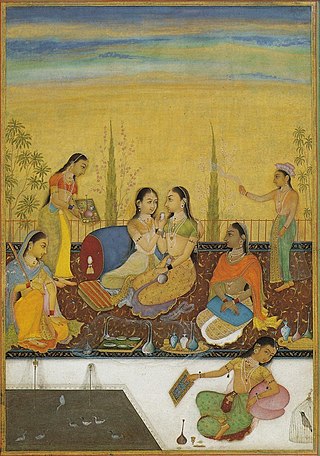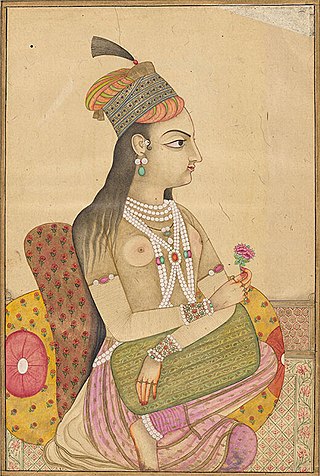Related Research Articles

The Chishtī Order is a tariqa, an order or school within the mystic Sufi tradition of Sunni Islam. The Chishti Order is known for its emphasis on love, tolerance, and openness. It began with Abu Ishaq Shami in Chisht, circa 930 AD in a small town near Herat, a strategic city in then Eastern Persia, which later became independent and then part of Afghanistan.

Jahanara Begum was a princess of the Mughal Empire. She was the second and the eldest surviving child of Mughal Emperor Shah Jahan and Mumtaz Mahal.

Abu'l Hasan Yamīn ud-Dīn Khusrau, better known as Amīr Khusrau, was an Indo-Persian Sufi singer, musician, poet and scholar who lived during the period of the Delhi Sultanate.
Sultan-ul-Mashaikh, Mahbub-e-Ilahi, Sheikh Khwaja Syed Muhammad Nizamuddin Auliya, also known as Hazrat Nizamuddin, and Mahbub-e-Ilahi was an Indian Sunni Muslim scholar, Sufi saint of the Chishti Order, and is one of the most famous Sufis from the Indian Subcontinent. His predecessors were Fariduddin Ganjshakar, Qutbuddin Bakhtiyar Kaki, and Moinuddin Chishti, who were the masters of the Chishti spiritual chain or silsila in the Indian subcontinent.

Dara Shikoh, also known as Dara Shukoh, was the eldest son and heir-apparent of the Mughal emperor Shah Jahan. Dara was designated with the title Padshahzada-i-Buzurg Martaba and was favoured as a successor by his father and his elder sister, Princess Jahanara Begum. He had been given the title of 'Sultan Buland Iqbal' by Shah Jahan. In the war of succession which ensued after Shah Jahan's illness in 1657, Dara was defeated by his younger brother Prince Muhiuddin. He was executed in 1659 on Aurangzeb's orders in a bitter struggle for the imperial throne.

Sultan Bahu, was a 17th-century Punjabi Sufi mystic, poet, scholar and historian. He was active in the Punjab region during the reigns of Mughal emperors Shah Jahan and Aurangzeb.

Mirza Shah Shuja was the second son of the Mughal Emperor Shah Jahan and Empress Mumtaz Mahal. He was the governor of Bengal and Odisha and had his capital at Dhaka, in present day Bangladesh.

Zenana literally meaning "of the women" or "pertaining to women", in Persian language contextually refers to the part of a house belonging to a Muslim, Sikh, or Hindu family in the Indian subcontinent, which is reserved for the women of the household. The zenana are the inner apartments of a house in which the women of the family live. The outer apartments for guests and men are called the mardana. Conceptually in those that practise purdah, it is the equivalent in the Indian subcontinent of the harem.

Syed Muhammad ibn Yousuf al-Hussaini, commonly known as Khwaja Banda Nawaz Gesudaraz, was a Hanafi Maturidi scholar and Sufi saint from India of the Chishti Order.

Zeb-un-Nissa was a Mughal princess and the eldest child of Emperor Aurangzeb and his chief consort, Dilras Banu Begum. She was also a poet, who wrote under the pseudonym of "Makhfi".
Makhdoom Alauddin Ali Ahmed Sabir, also known as Sabir Kaliyari, was an Indian Sunni Muslim preacher and Sufi saint in the 13th century. He was nephew successor to Baba Fareed (1188–1280), and the first in the Sabiriya branch of the Chishti Order. Today, his dargah is in Kaliyar town, near Haridwar in Uttarakhand state, India. The dargah is one of the most revered shrines for Muslims in India, after Ajmer Sharif at Ajmer.

Sufism has a history in India evolving for over 1,000 years. The presence of Sufism has been a leading entity increasing the reaches of Islam throughout South Asia. Following the entrance of Islam in the early 8th century, Sufi mystic traditions became more visible during the 10th and 11th centuries of the Delhi Sultanate and after it to the rest of India. A conglomeration of four chronologically separate dynasties, the early Delhi Sultanate consisted of rulers from Turkic and Afghan lands. This Persian influence flooded South Asia with Islam, Sufi thought, syncretic values, literature, education, and entertainment that has created an enduring impact on the presence of Islam in India today. Sufi preachers, merchants and missionaries also settled in coastal Gujarat through maritime voyages and trade.

Islam in Uttar Pradesh is the second largest religion in the state with 38,483,967 adherents in 2011, forming 19.26% of the total population. Muslims of Uttar Pradesh have also been referred to as Hindustani Musalman. They do not form a unified ethnic community, but are differentiated by sectarian and Baradari divisions, as well as by language and geography. Nevertheless, the community shares some unifying cultural factors. Uttar Pradesh has more Muslims than any Muslim-majority country in the world except Indonesia, Pakistan, Bangladesh, Nigeria, Egypt, Iran and Turkey.

Ajmer Sharif Dargah is a Sufi Tomb (dargah) of the Sufi saint, Khawaja Moinuddin Chishti, located at Ajmer Shareef, Rajasthan, India.

Shaykh Muhibullah Allahabadi, or Muhibb ullah Ilahabadi was a Sufi scholar who was active in Allahabad in northern India during the reign of the Mughul emperor Shah Jahan. He is noted as a leading proponent of the Sufi doctrine of Wahdat al-Wujud, sometimes called "Oneness of Being". Some Sufis consider that he was a saint.
Bholoo Shah or Bholu Shah also called Shah Behlan and Bhollo Shah was an 18th-century Muslim Sufi saint from Delhi, India. He was a Majzoob who belonged to the Qadri order. His dargah (mausoleum) is in Old Delhi, India.

Panchtoliya was an old cotton cloth of the Mughal period. The Panchtoliya was very light in weight and used for the veil. It was weighing only 2-5 tola per piece. The credit of Panchtoliya goes to the Mughal empress Nur Jahan. She was very fashion enthusiastic, encouraged, and introduced many styles and varieties of cloths of her interest. Few examples are Panchtoliya, badla, kinari, and Dudami weighing just two dams. Nur Jahan is also credited for specific dresses. For instance, nurmahali for the wedding is one of them.
After the mid-16th century, many Rajput rulers formed close ties with the Mughal emperors and served them in various capacities. It was because of the Rajputs that Akbar was not able to make complete Mughal Empire in India. The Rajput vassals had their daughters and sisters married to the Mughal emperors and their princes. For example, Akbar performed 40 marriages for himself and for his sons and grandsons, of which 17 were Rajput-Mughal alliances. The successors of the Mughal emperor Akbar, the mothers of his son Jahangir and grandson Shah Jahan were Rajputs. The Sisodia Rajput family of Mewar made it an honor not to enter into matrimonial relations with the Mughals, and thus stood in contrast to all other Rajput clans. After this time, the marital relations between the Rajputs and the Mughals declined somewhat. Akbar's relations with the Rajputs began when he returned in 1561 from a visit by the Chisti Sufi Shaikh of Sikri, west of Agra. Then many Rajput princesses married Mughal emperor Akbar.
The Bibliography of Mu'in al-Din Chishti is a selected list of generally available scholarly sources related to Mu'in al-Din Chishti, the Chishti Order Sufi saint from India.
Risala-i-Sahibiyah is a handwritten book by Jahanara Begum.
References
- ↑ Haeri, Shaykh Fadhlalla; Haeri, Muneera (2019-05-14). Sufi Encounters: Sharing the Wisdom of Enlightened Sufis. Watkins Media Limited. ISBN 978-1-78678-344-8.
- ↑ Mukherjee, Soma (2001). Royal Mughal Ladies and Their Contributions. Gyan Books. pp. 43, 72, 177–178. ISBN 978-81-212-0760-7.
- 1 2 Huq, Sabiha (2022-04-15). The Mughal Aviary: Women's Writings in Pre-Modern India. Vernon Press. pp. 74–78. ISBN 978-1-64889-427-5.
- ↑ Jain, Simmi (2003). Encyclopaedia of Indian Women Through the Ages: Ancient India. Gyan Publishing House. pp. 175, 257. ISBN 978-81-7835-116-2.
- ↑ Nath, Renuka (1990). Notable Mughal and Hindu Women in the 16th and 17th Centuries A.D. Inter-India Publications. p. 134. ISBN 978-81-210-0241-7.
- ↑ Chandra, Satish (2008). Social Change and Development in Medieval Indian History. Har-Anand Publications. ISBN 978-81-241-1386-8.
- ↑ Dallh, Minlib (2023-11-07). Sufi Women and Mystics: Models of Sanctity, Erudition, and Political Leadership. Taylor & Francis. ISBN 978-1-000-95802-7.
- ↑ Md, Hamiuddin Khan (1967). History of Muslim Education. Acedemy [sic] of Educational Research, All Pakistan Educational Conference. p. 123.